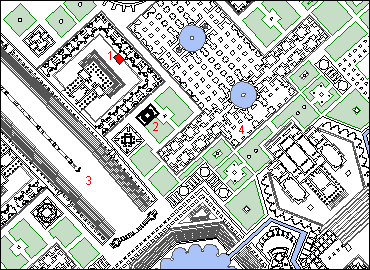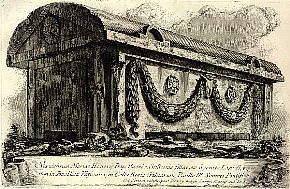Catalogo
Sepolcro di Maria moglie dell’imp. Onorio. Dal lib. 5 cap. 10 di Luc. Fauno delle antich. di Roma. «Pochi anni fa, die’egli, nella cappella del Re di Francia, che è nella Chiesa di S. Pietro essendosi posto in esecuzione il disegno proposto dqa GiulioII, fu trovata una cassa di marmo, che da quanto vi è stato ritvovato, ben si vede essere stata il Sepolcro di Maria moglie dell’imperador Onorio. Niente vi rimaneva del di lei cadavere, eccettuatone i denti, i capelli ed i stinchi. Dell’abito poi perchè era tessuto d’oro, ne furono ricavate molte lubbre d’oro, mentre fu arso. Vi fu trovata una cassetta d’argento lunga un piede e mezzo, e alta un palmo, e molti altri vasi di crtallo, e di quella materia che si chiama agata, eccellentemente lavorati. Inoltre vi furon vi fu uno smeraldo, in cui era incisa una testa. Si crede che questa sia stata d’ornorio, stimata cinquecento zecchini d’oro. Vi era una bolla interziata di gemme, la quale avea queste lettere d’intorno, == Maria nostra florentissim. == Inoltre una laminetta d’oro con queste parole in Greco, == Michele, Gabriele, Raffaele, Uriele. == Fra gli altri orecchini, vezzi ed altri simili ornamenti di donne, che erano in quella cassetta, vi era una specie di groppo di smeraldi, e di varie gemme, e un ornamento di puro oro, che si chiama rizza. Oltre a ciò aveva la lunghezza di un palmo da un lato queste parole. DOMINO NOSTRO HONORIO, dell’altra DOMINA NOSTRA MARIA. Un sorce di pietra celidonia. Una conchiglia, ed una coppa di cristallo. Una palla d’oro rotonda similissima a quelle da giuocare, che facilmente poteva aprirsi, essendo divisa in due parti a guisa di noce. Innumerevoli altre gemme le quali sebben erano per la maggior parte guaste dall’antichità nondimeno alcune conservavano l’antico spendore come se fossero nuove e recenti.»
Sep. Mariae Honorij Congiig.
1998.08.01
The Sepulchrum Mariae Honorij Congiig., the tomb of Empress Maria the first wife of Honorius, is the second to last building of ancient Rome designated within the Ichnographia Campus Martius. Piranesi mistakenly represents the tomb of Maria as separate from the tomb of Honorius; Maria's death may well have been the reason Honorius erected his family mausoleum around 400. Despite Piranesi's incorrectness, the position of Maria's tomb on the large plan falls within the area of the Vatican Hill that is actually occupied by St. Peter's Basilica, thus adding some veracity to the sepulcher's location. Moreover, Maria's tomb is within a courtyard surrounded on three sides by what appear to be other sepulchers whose placement within the Ichnographia partially coincides with the necropolis still in existence under St. Peter's Basilica, which is the traditionally held burial place of St. Peter himself. Another interesting detail is Piranesi's placement of Maria's tomb directly in front of the Templum Apollonis that is attached to the Circus of Caligula and Nero. According to "The Life of Sylvester" within the Liber Pontificalis, the original St. Peter's Basilica was built "in the shrine of Apollo," thus indicating that Piranesi's placement of the sepulcher of Maria within the Ichnographia was not altogether incorrect, but rather subtly and cleverly making note of the ancient Rome's pagan to Christian inversion.
| |

Sep. Mariae Honorij Congii.
The Sepulchrum Mariae Honorij Congiig. is designated as a simple solid rectangle within the Horti Neroniani of the Ichnographia.
The tomb of Maria was discovered 3 February 1544.
|

A translation of the footnote text under the Sep. Mariae Honorij Congiig entry within the Il Campo Marzio "Catalogo":
Sepulcher of Maria wife of the emp. Honorius. From bk. 5 ch. 10 of Luca Fauno on the antiq. of Rome. "A few years ago," he says, "in the chapel of the King of France which is in the Church of S. Peter's, as the [construction] project put forth by Julius II was being implemented, a marble chest was found, which, from what was found of it, appears clearly to have been the Sepulchre of Maria the wife of the emperor Honorius. There remained nothing in it of her corpse, except for her teeth, hair and shinbones [amusingly, that's pronounced "stinky"]. From her clothes, since they were woven of gold, were recovered many pounds [your text should have "libbre'] of gold, since they were incinerated [here the text reads ambiguously: either in Antiquity, or, and I give this an edge, by the discoverers]. A silver chest was found in it a foot and a half long and one palm high, and many vases of crystal and of that material called agate, excellently worked. In addition there were there was [sic] an emerald on which a head was engraved. It is thought that the head is that of Honorius, and is worth five hundred gold sequins. There was a seal inlaid with gems, that had these letters encircling it == Maria nostra florentissim. == In addition a thin gold plate with these words in Greek, == Michael, Gabriel, Raphael, Uriel. == Among the other earrings, necklaces and other women's ornaments in this chest, there was a kind of knot of emeralds a various gems, and an ornament of pure gold, called a "rizza". Furthermore on one side there were these words extending to one palm in length: DOMINO NOSTRO HONORIO; on the other DOMINA NOSTRA MARIA. A ["sorce": mouse??] of chelidonium [almost certainly: a specific type of agate with marking like tortoise-shell]. A shell, and a cup [,] of crystal. A round gold ball very much like those you play with, that could be very easily opened, divided into two compartments like a walnut. Innumerable other gems, most of which, however, were ruined by age, yet some retained their ancient splendor as if they were new and recent."
translation: Bill Thayer
| |
Sepulchrum Mariae Honorij Congiig. in context:
The Tomb of Empress Maria (1) is situated in front of the Templum Apollinis within a courtyard surrounded by what seem to be rows of other sepulchers. This temple precinct is between the Circus Caij et Neronis (3) and the Porticus Neronianae (4). The actual site of the tomb was most likely within the mausoleum of Honorius (2), which at one time was along what once was the spina of the Circus of Caligula and Nero.
|
| |
Really Good Architecture
2001.01.15
...this morning the postman delivered a Piranesi print, a print which I successfully bid on last weekend at eBay. It was the architecture of eBay that brought me Piranesi's engraving of ancient Rome's last Imperial artifact. I was confident in bidding on the print online via a written description and two digital images because of the Piranesi research that I have done and continue to do at home, online, and at university libraries. [By the way, Piranesi is a great proto-virtual-place architect.] This print of the sarcophagus of Maria, wife of the Emperor Honorius, was originally published within Piranesi's Il Campo Marzio (1762), specifically at the head of the dedicatory letter to Robert Adam. In true inversionary fashion, Piranesi cleverly placed an image of ancient Rome's last Imperial artifact at the beginning of the Il Campo Marzio publication.

Sarcophagus of the Empress Maria
The last imperial artifact of ancient Rome
2001.03.04
Burial of the sarcophagus containing the remains of Maria, the first wife of the Emperor Honorius, occurred circa 400 AD within the Mausoleum of Honorius, a structure then newly attached to the south transept of the original Basilica of Saint Peter.
|